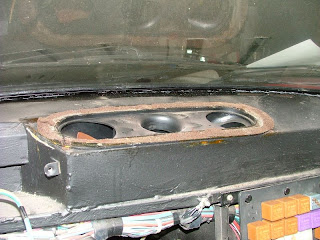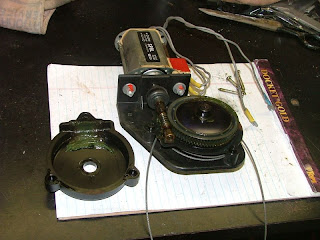As the days get short and the temperature drops, it's been tougher to carve out time to get in the shop. I'm waiting for my headlight switch stalk to return and thought I'd pay some attention to some things in the interior. Most of the electrical stuff works now, but a few remaining things bug me. One of them was the "slow down" lights.
This car has two catalytic converters -- one for cylinder banks 1-4 and the other 5-8. Each cat has a thermocouple to monitor temperature. If the cat temp gets too high, the thermocouple sends a trigger to an ECU and the corresponding "slow down" light comes on. When you start the car, these lights are supposed to come on for a few seconds, then go out. For some reason, my lights did not work at all. I looked at the wiring diagram and located the ECUs but did not see anything out of the ordinary. I pulled the light holders out of the dash and immediately saw the problem. Turn out that someone in the past pulled out the bulbs for the indicators! I put in some bulbs and magically, the lights come on at startup. Why would anyone disable an important system like this? If one of the cylinder banks has a problem and starts to overheat, I'd sure like to know!

Another thing I did was remove the stereo. I think that it works, but I wanted to pull it out to clean up some wiring. When I looked in the dash, I found this lovely gem.

Behind the stereo hole, there is a bundle of black grounding wires. Somehow, one of the wires had become severed and a few others were damaged. Some brainiac had soldered a patch wire in there and wrapped the mass in duct tape. Ugly. I guess I can sort of understand it -- they are
only ground wires and it's incredibly tough to get in there to fix it right. Someone was just lazy and didn't want to do the work. Just short of removing the entire dash, there's not a simple way to get to the harness to do a proper fix. I read a few posts on F-chat about dash removal and it doesn't look too tough. I may do it just to be able to fix this correctly. Now's a good time anyway as I have the steering wheel off and column switches removed.
Aside from wiring, I also started working on interior upholstery. I spent a lot of time scraping and cleaning off the old foam. A few of the pieces now have new foam glued on and I may have to move the operation indoors where it's a little warmer. I'm using Welwood contact cement which is taking too long to dry in my cold shop.
The last thing I did was pull the right front brake caliper to pull out the stupid plastic bag that got wrapped around the axle. However, it's not so simple as there is a hard brake line covering one of the mounting bolts.

I removed the brake line and the fluid started to come out. Even though I stuffed part of a rag into the hole, I could not keep it from leaking. I got the caliper off, pulled out the rest of the plastic and put the caliper back on as quickly as I could but was still left with a huge mess on the floor. By then it was cold and dark and my finger was gushing blood from getting smashed by an ill-aimed mallet blow so I decided to call it a night.

















